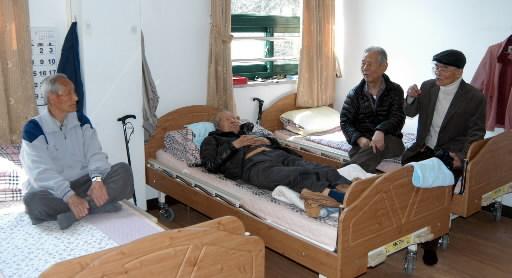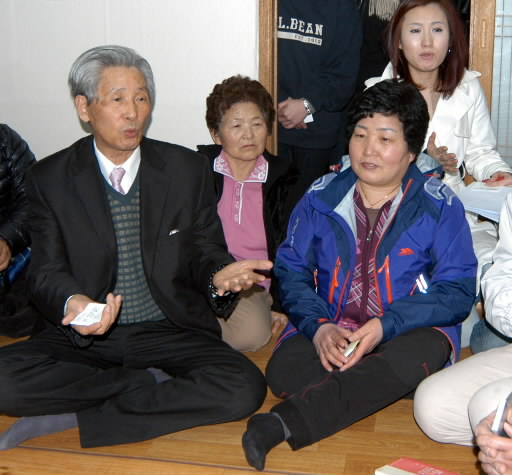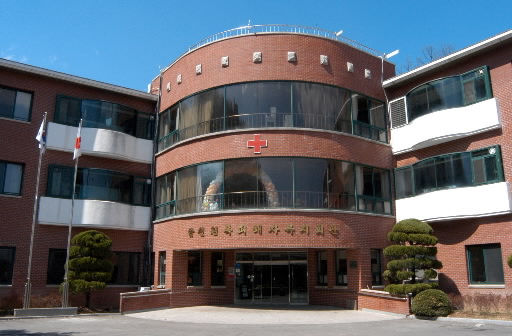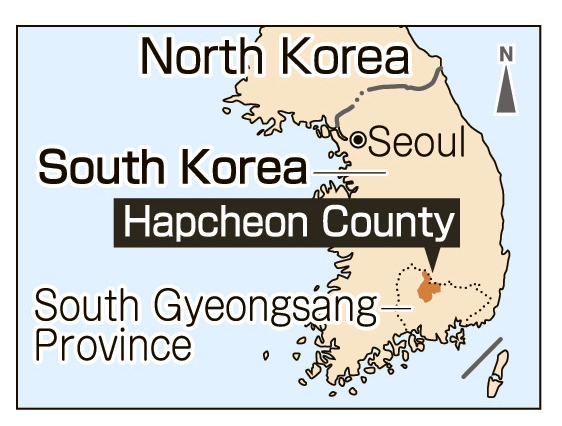Report from Hapcheon, the “Hiroshima of Korea”
Apr. 1, 2012
Atomic bomb survivors: 67 years weigh heavily
Story and Photos by Michiko Tanaka, Staff Writer
After the war, many atomic bomb survivors returned to Hapcheon County in South Gyeongsang Province in South Korea, an area sometimes referred to as the “Hiroshima of Korea.” The Chugoku Shimbun traveled to Hapcheon County in late March, timing the trip to coincide with an anti-nuclear and peace festival held there. Sixty-seven years after the atomic bombing, there are still disparities in the support for survivors living in Japan and those residing overseas. Meanwhile a new effort to seek support for overseas survivors has been undertaken.
Need for witnesses poses obstacle to obtaining survivor’s certificate
Made up of quiet villages nestled in the mountains, Hapcheon County is five hours from Seoul by car. On the fringes of the county is the Hapcheon A-bomb Sufferers Welfare Center, the only nursing home for atomic bomb survivors in South Korea.
The facility currently has 105 residents, whose average age is 79. Residents greeted me as soon as I entered, welcoming me and inviting me to eat with them in Japanese mingled with Hiroshima dialect.
Jung Jung Oh, 84, spoke softly in fluent Japanese. “I don’t want anything in particular. I just want to live quietly,” he said.
Many residents of Hapcheon County left for Hiroshima in the 1910s and, after succeeding in business there, sent for their relatives, many of whom followed them to Hiroshima. Mr. Jung was brought to Ujina in Minami Ward in Hiroshima by his parents shortly after he was born.
Mr. Jung was the second son in a family of nine children. In 1945 he was 18 and working at a transport job to help support his family. At the time of the dropping of the atomic bomb he was in Koi in Nishi Ward. He survived, but both of his legs were severely injured. After returning to South Korea following the war, he was compelled to serve on the front lines of the Korean War in his hometown, which had become a battleground. “There were few happy times,” he said.
He indicated that something was bothering him. “People were exposed to radiation in Japan. I want the government to do something for them,” he said, expressing his concern for the victims of the disaster in far-off Fukushima.
Kim Iljo, 83, was in Eba in Naka Ward at the time of the atomic bombing. “There are atomic bomb survivors who can’t get a survivor’s certificate even if they want one,” he said. Mr. Iljo has often accompanied survivors who live in South Korea to Hiroshima to apply for a certificate.
Atomic bomb survivors became able to file applications for an atomic bomb survivor’s certificate from overseas when the revised Atomic Bomb Survivors Relief Law took effect in December 2008. But according to the South Korean Atomic Bomb Sufferers Association, of the 2,650 registered survivors in South Korea, 129 still do not have certificates. Of the approximately 640 survivors registered with the Hapcheon branch of the association, 37 still do not have a certificate.
One major reason for this is that many survivors can not find a witness to support their application for the issuance of a certificate. The passage of 67 years since the atomic bombing weighs heavily.
If asked to do so, Mr. Kim will describe his atomic bombing experience to visitors to the facility. “I want to let people know that the atomic bomb creates problems even for the survivors’ children and grandchildren,” he said. He even gave an account of his experiences on the day he entered the hospital for stomach surgery.
South Gyeongsang Province, site of Hapcheon County
Regulations in support of three generations
Efforts of children of survivors pay off
In December 2011, the provincial assembly of South Gyeongsang Province, where Hapcheon County is located, passed regulations in support of the atomic bomb survivors. The regulations, which apply to survivors of the atomic bombings of Hiroshima and Nagasaki as well as their children and grandchildren, provide ongoing support for them. An effort to gain support for survivors led by the second generation was a driving force behind the passage of the regulations.
The regulations stipulate that the provincial governor must provide various services including the following: regular surveys on the situations of the atomic bomb survivors residing in the province and their children and grandchildren; the formulation of annual support plans; and social welfare support for atomic bomb survivors. Although the survivors in South Korea have received medical assistance from the governments of both South Korea and Japan, there were no laws or regulations providing a basis for the aid.
Behind the growing momentum for the movement to enact regulations was the death of Kim Hyong-Ryul, the son of an A-bomb survivor who was a central figure in the movement. Mr. Kim, who founded the Organization for the Suffering Second Generation of Korean Atomic Bomb Victims, died of lung disease in 2005 at the age of 34.
Mr. Kim’s mother was a survivor of the atomic bombing of Hiroshima. Mr. Kim had suffered from pneumonia since childhood and was diagnosed with a congenital immunity disorder. He formed the organization for second-generation sufferers in 2002 and called for compensation and support for them. In 2010 the Hapcheon House of Peace, an organization that provides support for atomic bomb survivors, was established in accord with Mr. Kim’s wishes.
Mun Junhu, 52, a native of Hapcheon County and a member of the provincial assembly, said, “Many people in South Korea hide the fact that they are atomic bomb survivors or the children of survivors because they are afraid of being discriminated against. When these regulations are implemented, we will be able to provide support to more people.”
Seven years have passed since the death of Kim Hyong-Ryul. His father, Kim Bong De, 75, a resident of Busan, supports the activities of his organization his son founded as an adviser. He was pleased by the enactment of the regulations. “I would like the second-generation survivors in Japan to speak out also,” he said.
Keywords
Hapcheon A-bomb Sufferers Welfare Center
The Hapcheon A-bomb Sufferers Welfare Center was erected with an allocation from a 4 billion fund for humanitarian assistance established by the Japanese government in the 1990s. The center opened in 1996 and was expanded in 2009 to increase its capacity from 80 residents to 110. It has three floors above ground and a basement and includes a clinic, visiting rooms and other facilities in addition to residents’ rooms. Operated by the Republic of Korea National Red Cross, the center currently has 105 residents ranging in age from 67 to 91. Of these 70 are natives of Hapcheon County.
(Originally published on April 2, 2012)











